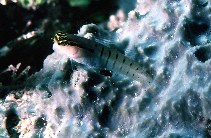| Family: |
Blenniidae (Combtooth blennies), subfamily: Salariinae |
| Max. size: |
5 cm TL (male/unsexed) |
| Environment: |
demersal; marine; depth range 4 - 12 m |
| Distribution: |
Western Central Pacific: Indonesia. |
| Diagnosis: |
Dorsal spines (total): 12-12; Dorsal soft rays (total): 13-13; Anal spines: 2-2; Anal soft rays: 15-15. Pale brown with yellow-edged dark brown stripe connecting eyes and continuing from rear edge of eye to upper edge of opercle' large dark brown spot just above pectoral fin and 1-2 smaller spots just above (below first 5 dorsal spines), about 9 dark brown bars or vertically aligned pair of spots on side of body, and bluish abdomen. Fin deeply notched; cirrus present on posterior rim of anterior nostril; last lateral-line tube below 8th or 9th dorsal spines; body depth at anal-fin origin about 4.5-5.8 in SL (Ref. 90102). |
| Biology: |
Oviparous. Eggs are demersal and adhesive (Ref. 205), and are attached to the substrate via a filamentous, adhesive pad or pedestal (Ref. 94114). Larvae are planktonic, often found in shallow, coastal waters (Ref. 94114). |
| IUCN Red List Status: |
Vulnerable (VU); Date assessed: 25 March 2009 (D2) Ref. (130435)
|
| Threat to humans: |
harmless |
Source and more info: www.fishbase.org. For personal, classroom, and other internal use only. Not for publication.

